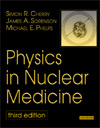|
|
|
| |
 |
|
|

|
 推薦指數:
推薦指數:





|
|
- 內容介紹
|
Physics in Nuclear Medicine, 3rd Edition
By Simon R. Cherry, Ph.D., James A. Sorenson, PhD and Michael E. Phelps, PhD
Approx. 544 pages, Approx. 150 illustrations, Copyright 2003Description
Experts in their fields provide up-to-date, comprehensive information on the physics underlying modern nuclear medicine and imaging using radioactively labeled tracers. They examine every aspect of the field--from basic atomic physics through radioactivity, isotope production, interaction of radiation with matter, radiation detection, and imaging systems. Examples are presented with solutions worked out in step-by-step detail, illustrating important concepts and calculations.
Key Features
Features a brand-new author, Dr. Simon Cherry, who contributes his cutting-edge knowledge in nuclear medicine instrumentation.
Presents a new introductory chapter, "What is Nuclear Medicine."
Revises and updates all chapters and appendices.
Discusses the hottest topics in the field, including isotope production and tracer synthesis • image quality in nuclear medicine • tomographic reconstruction in nuclear medicine • SPECT • PET • computers in nuclear medicine • and more.
Explains the analytic equations that describe the physics involved and illustrates them with graphs to make the material accessible to the non-math expert.
Provides more advanced mathematics and concepts in appendices.
Includes many new illustrations and examples throughout.
Reorganizes several chapters, providing a more logical flow of information.
Table of Contents
Cherry et al: PHYSICS IN NUCLEAR MEDICINE, 3/E TABLE OF CONTENTS: CHAPTER 1: What is Nuclear Medicine a. Fundamental Concepts b. The Power of Nuclear Medicine c. Historial Overview d. Current Practice of Nuclear Medicine e. The Role of Physics in Nuclear Medicine CHAPTER 2: Basic Atomic and Nuclear Physics a. Quantities and Units b. Radiation c. Atoms d. Nucleus CHAPTER 3: Modes of Radioiactive Decay a. General Concepts b. Chemistry and Radioactivity c. Decay by Emission d. Isomeric Transition and Internal Conversion e. Electron Capture and Decay f. Positron and Decay g. Competitive and EC Decay h. Decay by Emission and Nuclear Fission i. Decay Modes and the Line of Stability j. Sources of Information on Radionuclides CHAPTER 4: Decay of Radioactivity a. Activity b. Exponential Decay c. Methods for Determining Decay Factors d. Image-Frame Decay Corrections e. Specific Activity f. Decay of a Mixed Radionuclide Sample g. Parent-Daughter Decay CHAPTER 5: Isotope Production and Tracer Synthesis a. Reactor-Produced Radionuclides b. Accelerator-Produced Radionuclides c. Radionuclide Generators d. Equations for Radionuclide Production e. Radionuclides for Nuclear Medicine f. Radiiopharmaceuticals for Clinical Applications CHAPTER 6: Interaction of Radiation with Matter a. Interactions of Charged Particles with Matter b. Charged-Particle Ranges c. Passage of High-Energy Photons Through Matter d. Attenuation of Photon Beams CHAPTER 7: Radiation Detectors a. Gas-filled Detectors b. Semi-conductor Detectors c. Scintillation Detectors CHAPTER 8: Electronic Instrumentation for Radiation Detection a. Preamplifiers b. Amplifers c. Pulse-Height Analyzers d. Time-to-Amplitude Converters e. Digital Counters and Ratemeters f. Coincidence Units g. High-Voltage Power Supplies h. Nuclear Instrument Modules i. Cathode Ray Tube j. Oscilloscopes k. Computer Monitors CHAPTER 9: Nuclear Counting Statistics a. Types of Measurement Error b. Nuclear Counting Statistics c. Propagation of Errors d. Applications of Statistical Analysis e. Statistical Tests CHAPTER 10: Pulse Height Spectrometry a. Basic Principles b. Spectrometry with Nal c. Spectrometry with other Detectors CHAPTER 11: Problems in Radiation Detection and Measurement a. Detection Efficiency b. Problems in the Detection and Measurement of Particles c. Deadtime d. Qualtity Assurance for Radiation Measureme Systems CHAPTER 12: Counting Systems a. Nal Well Counter b. Counting with Conventional Nal Detectors c. Liquid Scintillation Counters d. Gas-filled Detectors e. Semiconductor Detector Systems f. In Vivo Counting Systems CHAPTER 13: The Gamma Camera: Basic Principles a. General Concepts of Radionuclide Imaging b. Basic Principles of the Anger Camera CHAPTER 14: Gamma Camera Performance Characteristics a. Basic Performance Characteristics b. Detector Limitations: Nonuniformity and Nonlinearit c. Design and Performance Characteristics of Parellel-Hole Collinators d. Performance Characteristics of Converging, Diverging and Pinhole Collimators e. Measurements of Camera Performance CHAPTER 15: Image Quality in Nuclear Medicine a. Basic Methods for Characterizing and Evaluating Image Quality b. Spatial Resolution c. Contrast d. Noise e. Detectability and Observer Performance Studies BOOKS OF RELATED INTEREST: Ziessman: NUCLEAR MEDICINE: Case Review: 2002: ISBN: 0-323-99658-2 Weissleder: PRIMER OF DIAGNOSTIC IMAGING, 3/E; 2002; ISBN: 0-323-02328-2 Mitchell: Grainger & Allison’s DIAGNOSTIC RADIOLOGY, 4/E; 2002; ISBN: 0-443-07254-X Thrall: NUCLEAR MEDICINE: The Requisites 2/e; 2001; ISBN: 0-323-00537-3 CHAPTER 16: Tomographic Reconstruction in Nuclear Medicine a. General Concepts, Notation and Terminology b. Backprojection and Fourier-Based Techniques c. Image Quality in FT and FBP Techniques d. Iterative Reconstruction Algorithms CHAPTER 16: Tomographic Reconstruction in Nuclear Medicine a. General Concepts, Notation and Terminology b. Backprojection and Fourier-Based Techniques c. Image Quality in FT and FBP Techniques d. Iterative Reconstruction Algorithms e. Reconstruction of Fan-Beam and Cone-Beam Data CHAPTER 17: Single Photon Emission Computed Tomography a. SPECT Systems b. Practical Implementation of SPECT c. Performance Characteristics of SPECT Systems d. Clinical Applications of SPECT CHAPTER 18: Positron Emission Tomography a. Annihilation Coincidence Detectioin b. PET Detector and Scanner Designs c. Dataa Acqusition for PET d. Data Corrections and Quantitative Aspects of PET e. Clinical and Research Applications of PET CHAPTER 19: Computers in Nuclear Medicine CHAPTER 20: Internal Radiation Dosimetry CHAPTER 22: Radiation Safety and Health Physics CHAPTER 23: Summary SG: Revised Pub 11/7/02
|
|
|

